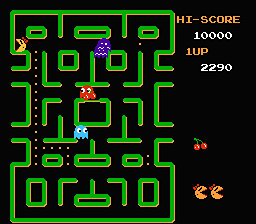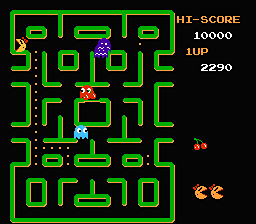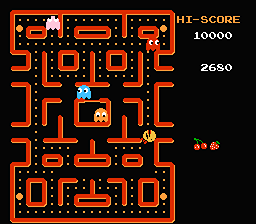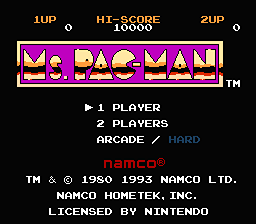
Ms. Pac-Man (1990-)
Developer: Midway
Publisher: Tengen
Genre: Maze
Ms. Pac-Man for the NES was developed by General Computer Corporation and published by Namco, with the North American release arriving in 1990. The game is a home console adaptation of the widely popular arcade title, which itself was a sequel and spin-off to the original Pac-Man. The NES version faithfully translates the arcade experience to a home setting, including the updated maze designs, smarter ghost behavior, and moving fruit bonuses introduced in the arcade version. While the NES adaptation did not receive ports to other consoles at the time, the Ms. Pac-Man character became an enduring icon, influencing future titles and crossovers within the franchise.
The game follows the classic maze-chase formula, with players controlling Ms. Pac-Man as she navigates a series of increasingly complex mazes, eating pellets while avoiding ghosts. Power pellets allow her to temporarily turn the tables, enabling her to eat the pursuing ghosts for bonus points. Bonus fruits appear in each maze and move across the screen, offering additional opportunities for points and requiring careful timing and strategy to capture. The core gameplay relies on reflexes, pattern recognition, and planning, while the NES version adds slightly faster pacing and refined controls compared to the arcade original.
Gameplay emphasizes timing, memorization, and strategic movement. Players must anticipate ghost behavior, balance risk and reward, and clear each maze to progress. The NES version maintains the original’s addictive challenge while allowing home players to enjoy the game without the time limits or coin requirements of the arcade. Levels grow progressively more difficult, with faster-moving ghosts, tighter maze layouts, and more aggressive AI, providing both newcomers and experienced players with a consistently engaging challenge.
The soundtrack features upbeat and energetic melodies that accompany each maze, while sound effects signal pellet consumption, ghost interactions, and bonus items. Promotion highlighted the game as a faithful NES adaptation of the beloved arcade classic, presenting Ms. Pac-Man as a fun and approachable heroine while retaining the familiar gameplay mechanics. Reception was positive, with praise for its faithful translation, addictive gameplay, and responsive controls, though some critics noted that the NES version’s graphics and sound were simpler than the arcade original. Ms. Pac-Man remains a celebrated NES title, solidifying its role in the legacy of the Pac-Man franchise and inspiring subsequent sequels and spin-offs across multiple platforms.
Images from MobyGames
Buy Ms. Pac-Man
Click one of the Ebay or Amazon buttons below to check the latest prices and purchase Ms. Pac-Man for the Nintendo Entertainment System.

Related Searches
Ms. Pac-Man NES Download
Ms. Pac-Man is available to purchase and download from a range of vendors. Always shop around...
Ms. Pac-Man NES Manual
Various repositories around the internet have scanned and archived a range of retro manuals. Search now to.....
Ms. Pac-Man NES Rom
We don't host or link to rom sites for this game. However, there are many sites out there that may be...
Ms. Pac-Man NES Walkthrough
Many sites - particularly YouTube - host a range of walkthrough videos to guide you in your quest to get...
Ms. Pac-Man NES Cheats
There are various sites out there that can offer cheat codes for games. Search now to find all available...
Ms. Pac-Man NES Controls
This information can often be obtained through the user manual. Alternatively there are many sites out there...
Ms. Pac-Man NES Release Date
The initial release date for Ms. Pac-Man is stated as May 1990. Other ports of the game may..
Ms. Pac-Man NES Review
There are many sites out there that have collated and documented historic reviews of this game. Search now...
Ms. Pac-Man Famicom
As a Nintendo Entertainment System release, this game was also likely also available on the Famicom. This....
Ms. Pac-Man NES Speedrun
There is now a community of competitive speedrunners who will try and gain the fastest possible time on their....








